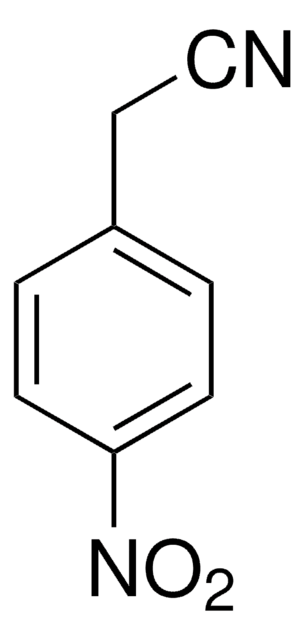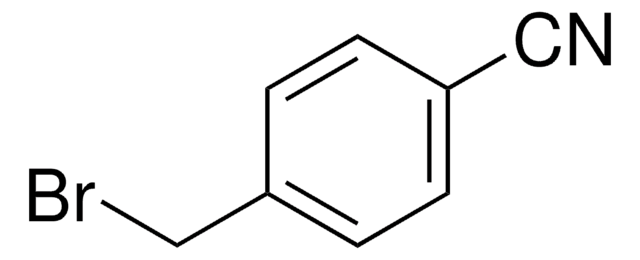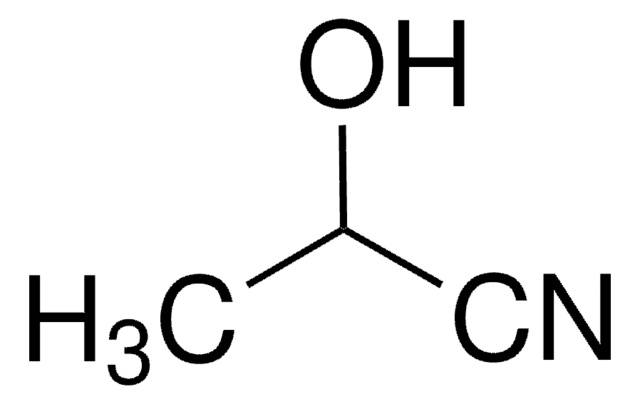추천 제품
Quality Level
분석
96%
refractive index
n20/D 1.5106 (lit.)
density
0.985 g/mL at 25 °C (lit.)
SMILES string
CC(C#N)c1ccccc1
InChI
1S/C9H9N/c1-8(7-10)9-5-3-2-4-6-9/h2-6,8H,1H3
InChI key
NVAOLENBKNECGF-UHFFFAOYSA-N
신호어
Warning
유해 및 위험 성명서
Hazard Classifications
Acute Tox. 4 Dermal - Acute Tox. 4 Inhalation - Acute Tox. 4 Oral - Eye Irrit. 2 - Skin Irrit. 2 - STOT SE 3
표적 기관
Respiratory system
Storage Class Code
6.1C - Combustible acute toxic Cat.3 / toxic compounds or compounds which causing chronic effects
WGK
WGK 3
Flash Point (°F)
201.2 °F - closed cup
Flash Point (°C)
94 °C - closed cup
개인 보호 장비
Eyeshields, Faceshields, Gloves, type ABEK (EN14387) respirator filter
시험 성적서(COA)
제품의 로트/배치 번호를 입력하여 시험 성적서(COA)을 검색하십시오. 로트 및 배치 번호는 제품 라벨에 있는 ‘로트’ 또는 ‘배치’라는 용어 뒤에서 찾을 수 있습니다.
Tamás Plaszkó et al.
Metabolites, 10(11) (2020-11-12)
The interaction between plant defensive metabolites and different plant-associated fungal species is of high interest to many disciplines. Volatile organic compounds (VOCs) are natural products that are easily evaporated under ambient conditions. They play a very important role in inter-species
Zhong-Liu Wu et al.
Biotechnology and applied biochemistry, 35(Pt 1), 61-67 (2002-02-09)
Racemic 2-phenylpropionitrile was resolved enantioselectively by nitrile-converting enzymes in cells of Rhodococcus sp. CGMCC 0497 to S-(+)-2-phenylpropionic acid and R-(-)-2-phenylpropionamide. By optimization of the culture conditions, great enhancement of enzyme activity and enantioselectivity was achieved. Furthermore, the relationship between cell-growth
Ondřej Kaplan et al.
BMC biotechnology, 11, 2-2 (2011-01-08)
Nitrilases attract increasing attention due to their utility in the mild hydrolysis of nitriles. According to activity and gene screening, filamentous fungi are a rich source of nitrilases distinct in evolution from their widely examined bacterial counterparts. However, fungal nitrilases
Zsolt Szűcs et al.
BMC plant biology, 18(1), 85-85 (2018-05-11)
The health of plants is heavily influenced by the intensively researched plant microbiome. The microbiome has to cope with the plant's defensive secondary metabolites to survive and develop, but studies that describe this interaction are rare. In the current study
T Gilligan et al.
Applied microbiology and biotechnology, 39(6), 720-725 (1993-08-01)
A new soil isolate, tentatively identified as Rhodococcus equi TG328, was found to be effective in the production of S-(+)-2-phenylpropionic acid from (R,S)-2-phenylpropionitrile. The conversion is catalysed by two enzymes. First, a nitrile hydratase converts the (R,S)-nitrile to (R,S)-2-phenylpropionamide. Second
자사의 과학자팀은 생명 과학, 재료 과학, 화학 합성, 크로마토그래피, 분석 및 기타 많은 영역을 포함한 모든 과학 분야에 경험이 있습니다..
고객지원팀으로 연락바랍니다.









